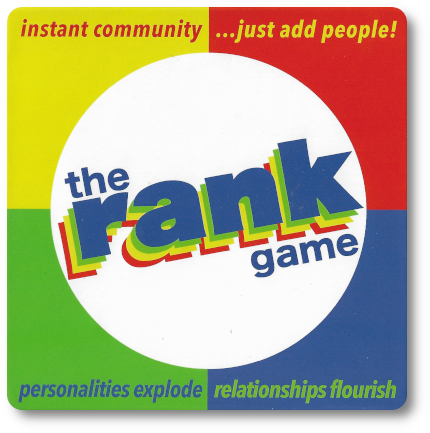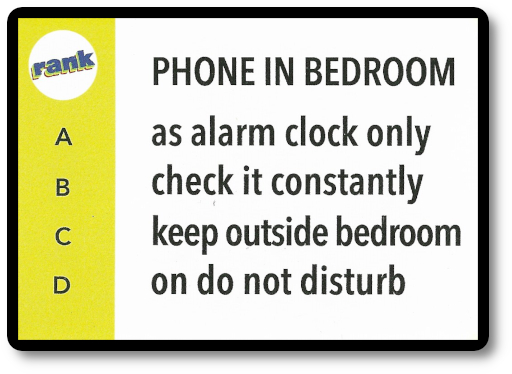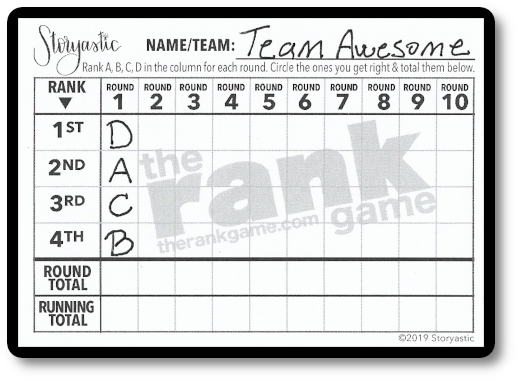Please Take Note: This is a review of the final game, but it might change slightly based on the success of the Kickstarter campaign. The game is being reviewed on the components and the rules provided with the understanding that “what you see is not what you might get” when the game is published. If you like what you read and want to learn more, we encourage you to visit the game’s website or visit the Kickstarter campaign. Now that we have all that disclaimer junk out of the way, on with the review.

The Basics:
- For ages 8 and up (publisher suggests 12+)
- For 2 or more players
- Variable game play length
Geek Skills:
- Active Listening & Communication
- Counting & Math
- Logical & Critical Decision Making
- Reading & Writing
- Cooperative & Team Play
Learning Curve:
- Child – Easy
- Adult – Easy
Theme & Narrative:
- How well do you know each other?
Endorsements:
- Gamer Geek rejected!
- Parent Geek approved!
- Child Geek mixed!
Overview
Brazilian lyricist and novelist Paulo Coelho, said “Writing means sharing. It’s part of the human condition to want to share things – thoughts, ideas, opinions.” Writing is but one form of how we share. We also share ideas, thoughts, and feelings through music, art, a conversation, and even through a light touch on someone’s shoulder when we pass them by. Of all these many ways we communicate with each other, how well do we know the person we are speaking and listening to? This game looks to answer that question.
The Rank Game, designed by Chip Brown, Dana Brown, and to be published by Storyastic, is comprised of 150 Topic cards, one wooden card stand, and two score pads (with a reported 162 score sheets – we didn’t count and are taking the publisher’s word for it). Not included with the game, but necessary to play, is a pen or pencil for each player to use to help keep track of their scores. As this is a review of a prototype version, I cannot comment on the game component quality. That being said, the copy I was given was of excellent quality (as in, it looks like it was published and available at a store near you). If the final version is expected to be “even better,” then the game will be very durable.
Getting Ready to Share
To set up the game, first give each player a single sheet from the score pad and something to write with.
Second, assign one player the role of “Ranker” and hand them the deck of Topic cards. The Ranker now shuffles the cards and draws one. While players are welcome to use the entire deck, it’s also recommended that a single color be used throughout the game. The colors identify the subject matter of the topics (green for life topics, yellow for everyday topics, and blue for leisure activities).
And that’s it for the game set up.
Listen, Learn, Laugh
There are several different methods of playing the game. Each is summarized here. The score sheet lists ten rounds of gameplay, but nothing is stopping the players from playing more or fewer rounds.
The Basic Game
The Ranker reads aloud the text on the Topic card to the other players and then places the card in the card stand, ensuring all players can read the card’s text with ease. After doing so, the Ranker reviews the list and secretly writes down their ranked personal preference of importance based on what is listed (from best to worst in most cases). For example, the Topic card shown below has the topic title of “Phone in the Bedroom.” In no particular order are four options. These include the following:
A) As alarm clock only
B) Check it constantly
C) Keep outside bedroom
D) On do not disturb

The Ranker lists on their score sheet the order (using the letters) of importance to them. Continuing the example, the score sheet listed here is my order preference using the provided list on the Topic card (listed from best choice to worse choice).

While the Ranker is listing their preference, the other players (known as the “Guessers” for reasons that will quickly become obvious) are attempting to guess the Ranker’s order and writing it down on their score sheet. Keep in mind that nothing is shared or discussed during this portion of the game round. It should be done in silence and secret.
After all the players have completed writing down the preference order, the Ranker reveals their score sheet, and all Guessers compare their list to it. A Guesser receives one point for each match, and the Ranker automatically gets two points for the round.
Rinse and repeat, with the role of Ranker changing every round.
The winner is the player with the most points at the end of the game.
Icebreaker
This is a simplified version of the basic game and does not require a score sheet. A player picks a Topic card, and everyone shares their preference order. Everyone wins.
Spotlight
Almost identical to the basic game, but the Ranker does not score any points by default. Only the Guessers. The idea here is to determine how well you know a person.
Teams of Two
This is the basic game but played with a team member. One team will be the Ranker each round, and the other teams are the Guessers. Same goal but with the bonus of teamwork.
Two Teams
Split the players into two different teams. Each team will have a Ranker, and the rest are Guessers. Guessers on the same team work together to guess the Ranker’s preference order. Have each team play the same cards and then compare the scores after each round.
To learn more about The Rank Game, visit the game’s website or visit the Kickstarter campaign.
Final Word
 The Child Geeks had fun playing the game but never saw it as something you should try to “win.” That is to say, not once did I hear or see anything to suggest that the players were competing for points. They were, however, supercharged up when they thought the Ranker ranked their preferences incorrectly. This lead to some rather heated discussions that more or less focused on how wrong the Guesser or the Ranker was. All in good fun, mind you, but it did cause a few outbursts of frustration and even one accusation of cheating. According to one Child Geek, “I think the game is best when I play it with my family. I think my friends are cheating or don’t understand what you are supposed to do as the Ranker.” In almost all cases, the ranking order should be personal preference from best to worst, but that is not necessarily the case. The rules do not say specifically (although there is an FAQ entry that lightly touches on it) what the order should be. I suggest the Ranker get into the habit of announcing how they will be ordering their list, and that should solve any issues. We tried this, and it was met with great success. As one Child Geek put it, “The game wasn’t broken, but telling everyone how you would order your list made everything feel better.” When the games were over, the Child Geeks gave the game a mixed review, finding it to be “OK” and “Fine,” but no one ever said they found it overly exciting or entertaining.
The Child Geeks had fun playing the game but never saw it as something you should try to “win.” That is to say, not once did I hear or see anything to suggest that the players were competing for points. They were, however, supercharged up when they thought the Ranker ranked their preferences incorrectly. This lead to some rather heated discussions that more or less focused on how wrong the Guesser or the Ranker was. All in good fun, mind you, but it did cause a few outbursts of frustration and even one accusation of cheating. According to one Child Geek, “I think the game is best when I play it with my family. I think my friends are cheating or don’t understand what you are supposed to do as the Ranker.” In almost all cases, the ranking order should be personal preference from best to worst, but that is not necessarily the case. The rules do not say specifically (although there is an FAQ entry that lightly touches on it) what the order should be. I suggest the Ranker get into the habit of announcing how they will be ordering their list, and that should solve any issues. We tried this, and it was met with great success. As one Child Geek put it, “The game wasn’t broken, but telling everyone how you would order your list made everything feel better.” When the games were over, the Child Geeks gave the game a mixed review, finding it to be “OK” and “Fine,” but no one ever said they found it overly exciting or entertaining.
 The Parent Geeks found the game to be an excellent exercise in sharing and improving communication with their children and even their spouse. According to one Parent Geek, “Games like this are not about winning or losing. They are about sharing and learning. I only get to see my kids on the weekends due to school activities and our busy family life. We used this game to slow down, catchup, and reconnect.” Another Parent Geek said, “Wow, you think you know a person! What I liked best about this game was what came after revealing the list order. I was able to learn more about my husband and my kids. For example, I had no idea my husband liked a clean car so much!” (This is in reference to a Topic card that lists items of sheer joy. One of them is a clean car. Others include finding money, clean sheets, and a new haircut…of which I know nothing about.) When all the reviews were in, the Parent Geeks gave The Rank Game their full approval, finding it to be a fun and creative way to share quality time with friends and family.
The Parent Geeks found the game to be an excellent exercise in sharing and improving communication with their children and even their spouse. According to one Parent Geek, “Games like this are not about winning or losing. They are about sharing and learning. I only get to see my kids on the weekends due to school activities and our busy family life. We used this game to slow down, catchup, and reconnect.” Another Parent Geek said, “Wow, you think you know a person! What I liked best about this game was what came after revealing the list order. I was able to learn more about my husband and my kids. For example, I had no idea my husband liked a clean car so much!” (This is in reference to a Topic card that lists items of sheer joy. One of them is a clean car. Others include finding money, clean sheets, and a new haircut…of which I know nothing about.) When all the reviews were in, the Parent Geeks gave The Rank Game their full approval, finding it to be a fun and creative way to share quality time with friends and family.
 The Gamer Geeks found the game to be of little interest, dismissing the game’s intent completely. According to one Gamer Geek, “I like what the game is attempting and its reasons for it, but I have never approved or will approve a game that isn’t a game. This is a tool. A means to start a conversation. You can do the same thing by pulling topics out of a hat, randomly rolling a value and comparing it to a list, or throwing darts at a board.” Another Gamer Geek said, “Good for young families, office parties, and mixed groups at parties. But a game for this elitist’s gaming table? Never. Let’s make sure we all recognize that when I say I reject this game, I do so because I don’t think it is a game a true gamer would play. But as a dad and as a chump who spends more time at the office with my co-workers than family, I’d say this was an OK distraction. But I wouldn’t select this as an activity if I had other options.” When all the votes were in, the Gamer Geeks rejected The Rank Game.
The Gamer Geeks found the game to be of little interest, dismissing the game’s intent completely. According to one Gamer Geek, “I like what the game is attempting and its reasons for it, but I have never approved or will approve a game that isn’t a game. This is a tool. A means to start a conversation. You can do the same thing by pulling topics out of a hat, randomly rolling a value and comparing it to a list, or throwing darts at a board.” Another Gamer Geek said, “Good for young families, office parties, and mixed groups at parties. But a game for this elitist’s gaming table? Never. Let’s make sure we all recognize that when I say I reject this game, I do so because I don’t think it is a game a true gamer would play. But as a dad and as a chump who spends more time at the office with my co-workers than family, I’d say this was an OK distraction. But I wouldn’t select this as an activity if I had other options.” When all the votes were in, the Gamer Geeks rejected The Rank Game.
 As always, take review comments (including any I provide) with a grain of salt. The Rank Game is a game in the academic sense and by the word’s very definition. But let’s also note that the groups I work with play a good number of competitive board, card, and dice games that have a great deal of strategy and tactics. The Rank Game provides a means to communicate with each other, but not compete in a way that takes skill. The scoring is altogether unnecessary and can be more of a burden than a boon. Keeping score adds weight to the importance of guessing correctly, but any individual who doesn’t know the Ranker can only imagine, which doesn’t feel right if you judge the value of your performance in the game by keeping track of points.
As always, take review comments (including any I provide) with a grain of salt. The Rank Game is a game in the academic sense and by the word’s very definition. But let’s also note that the groups I work with play a good number of competitive board, card, and dice games that have a great deal of strategy and tactics. The Rank Game provides a means to communicate with each other, but not compete in a way that takes skill. The scoring is altogether unnecessary and can be more of a burden than a boon. Keeping score adds weight to the importance of guessing correctly, but any individual who doesn’t know the Ranker can only imagine, which doesn’t feel right if you judge the value of your performance in the game by keeping track of points.
Which, again, is not the reason for the game in the first place. You are adding a competitive element, where there is one winner and a lot of losers. If we recognize that this is a game focused on opening up and sharing, labeling a person a winner or loser feels out of place. If you play the game, I suggest you skip the scoring. Just play it using the Icebreaker rules, and I think you’ll find this is a game that not only works well with families but also just about anywhere. I played it in the car while driving with my kids, with a group of friends as we sat waiting at a restaurant, and as a team activity at the office. Worked great because the intent of the game was not to win, but to share, listen, and learn.
Give this game a try if you are looking for a creative way to learn about others. I can guarantee that each round of gameplay will spark a discussion and opportunities to laugh.
This is a paid-for review of the game’s final prototype. Although our time and focus were financially compensated, our words are our own. We’d need at least 10 million dollars before we started saying what other people wanted. Such is the statuesque and legendary integrity of Father Geek, which cannot be bought except by those who own their own private islands and small countries.



